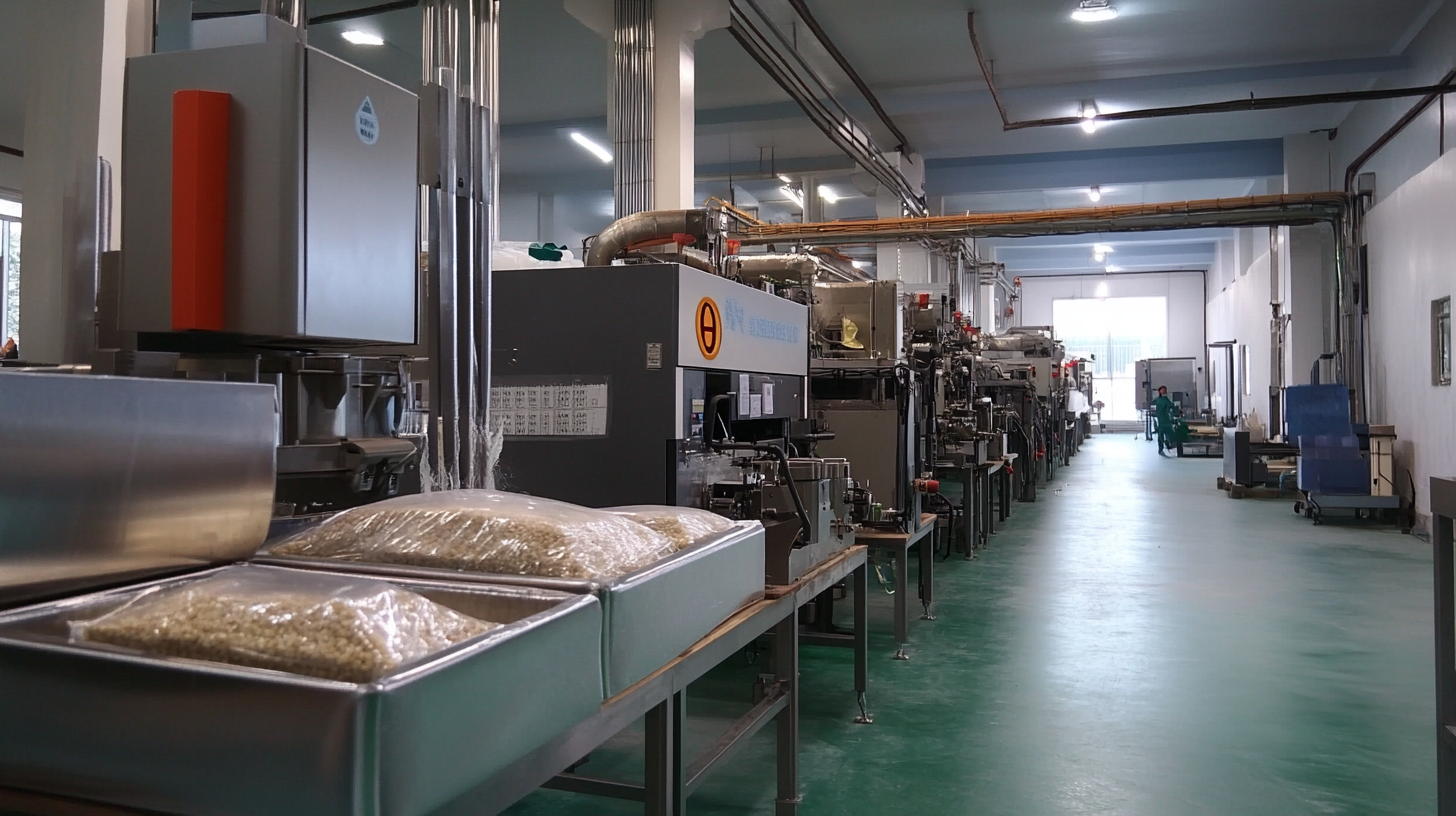A-B-C Blog
Quality Driven Food Packaging Equipment Innovating Chinese Manufacturing for Global Markets
In recent years, the food packaging equipment sector has experienced remarkable growth, driven by increasing consumer demand for convenience and safety. The global food packaging equipment market is projected to reach USD 50 billion by 2027, expanding at a compound annual growth rate (CAGR) of 5.3% from 2020 to 2027, according to a recent report by Fortune Business Insights. As one of the largest contributors to this market, China's manufacturing industry is leveraging innovation to enhance its competitiveness in global markets. With advancements in automation, sustainability, and smart technology, Chinese manufacturers are not only meeting domestic demands but are also positioning themselves as key players on the international stage. This blog will explore how quality-driven food packaging equipment is revolutionizing Chinese manufacturing and redefining standards for efficiency and sustainability in the food industry.

The Role of Quality Standards in Food Packaging Equipment for Global Competitiveness
The food packaging equipment industry is experiencing a surge in demand, driven by the increasing consumer preference for convenient and ready-to-eat food products. As the global food packaging equipment market is projected to grow from USD 21.40 billion in 2024 to an estimated CAGR of 5.3% by 2030, the imperative for quality-driven machinery has never been more pronounced. The shift towards convenience foods necessitates advanced processing and packaging solutions that meet stringent quality standards, ensuring the safety and longevity of packaged items.
Industry leaders are recognizing that adherence to quality standards is essential for maintaining competitiveness in the global market. For instance, the global packaging automation market is anticipated to grow from USD 74.56 billion in 2024 to approximately USD 136.47 billion by 2032. This expansion underscores the critical role of quality in fostering innovation and efficiency among manufacturers. The roundtable discussions led by Dr. Subrata Gupta have highlighted the need for collaboration among food processing and packaging machinery companies to align on best practices and quality benchmarks, which are vital for enhancing operational capabilities and global market positioning.

Key Innovations in Food Packaging Machinery Driving Chinese Manufacturing Forward
In the rapidly evolving landscape of global food production, Chinese manufacturers are setting new standards with cutting-edge innovations in food packaging machinery. One of the key advancements is the integration of smart technology, such as IoT and artificial intelligence, which enables real-time monitoring and control of packaging processes. This not only enhances efficiency but also ensures product safety and quality. By utilizing data analytics, manufacturers can optimize production lines and minimize waste, aligning with the growing demand for sustainability in food packaging.
Another significant innovation is the development of biodegradable and recyclable materials that cater to environmentally-conscious consumers. Chinese companies are increasingly investing in research to create sustainable packaging solutions that reduce environmental impact while maintaining the integrity of food products. This commitment to quality-driven practices is reshaping the food packaging industry, positioning Chinese manufacturers as leaders in both local and global markets. The blend of traditional manufacturing excellence with modern technological advancements is crucial in driving forward not just the Chinese manufacturing sector, but also meeting global standards and consumer expectations.
Quality Driven Food Packaging Equipment Innovating Chinese Manufacturing for Global Markets
| Innovation Type | Description | Impact on Manufacturing | Market Reach |
|---|---|---|---|
| Automated Packaging Systems | Integration of robotics for faster packaging. | Increased efficiency and reduced labor costs. | Domestic and international markets. |
| Eco-Friendly Materials | Use of sustainable materials in packaging. | Improved brand image and compliance with regulations. | Growing markets focused on sustainability. |
| Smart Packaging Technology | Integration of IoT for monitoring freshness. | Enhanced product traceability and safety. | Global food safety markets. |
| Modular Packing Machines | Flexible systems that can be easily reconfigured. | Adaptability to different product lines and sizes. | Versatile across various food sectors. |
Market Trends: The Impact of Sustainable Packaging on Chinese Manufacturers
The global shift towards sustainable packaging is redefining the landscape for Chinese manufacturers, as they increasingly focus on eco-friendly solutions to meet growing consumer demands. Recent market trends indicate a significant expansion in various packaging sectors, including biodegradable options. For instance, the mycelium-based packaging market is projected to reach a value of $84.9 million in 2024, with an impressive compound annual growth rate (CAGR) of over 9.4% anticipated until 2034. This indicates a robust demand for sustainable and biodegradable packaging that aligns with environmental goals.
Tips for manufacturers looking to pivot toward sustainable packaging include investing in research and development to explore innovative materials that reduce environmental impact. Collaboration with suppliers of sustainable materials can also enhance product offerings and attract eco-conscious consumers. Additionally, embracing certifications and eco-labels can bolster brand credibility and increase market appeal, especially as consumers are increasingly prioritizing sustainability in their purchasing decisions.
Moreover, focusing on functionality and convenience in packaging design can amplify market reach. As the multi-functional flexible packaging market is expected to grow significantly, manufacturers should consider creating versatile packaging solutions that cater to the needs of modern consumers while maintaining sustainability at the core of their operations. The future of packaging is undoubtedly green, pushing manufacturers to innovate and adapt in a competitive global market.
Market Trends: The Impact of Sustainable Packaging on Chinese Manufacturers
Data Insights: Growth Projections for Food Packaging Equipment in China Through 2025
The food packaging equipment industry in China is on a robust growth trajectory, driven by increasing demand from global markets. As indicated in recent projections, the overall packaging machinery market is estimated to reach approximately USD 64.8 billion by 2025, with an anticipated growth rate of 4.5% CAGR from 2025 to 2035. Specifically, the blister packaging equipment sector is expected to flourish, with its market projected to reach $4.1 billion by 2030, reflecting a shift towards unit-dose packaging in pharmaceuticals and consumer goods.
In China, the solid packaging segment is particularly noteworthy, forecasted to grow significantly and achieve a valuation of $3.5 billion by 2030. This growth is largely fueled by innovations in quality-driven packaging solutions that cater to both domestic consumption and international export. Furthermore, the evolving preferences for sustainable packaging and automation in manufacturing processes hint at a vibrant landscape for future investments. As the industry adapts to these emerging trends, the integration of advanced technologies will be crucial in positioning Chinese manufacturers as leaders in the global food packaging arena.
Growth Projections for Food Packaging Equipment in China Through 2025
Case Studies: Successful Globalization of Chinese Food Packaging Solutions
The globalization of Chinese food packaging solutions has transformed the landscape of the industry, showcasing innovative case studies that exemplify success. One notable case is a Chinese manufacturer that implemented advanced automation technology, significantly increasing production efficiency while maintaining stringent quality standards. By leveraging robotics and smart packaging systems, they not only reduced labor costs but also enhanced precision in packaging, allowing products to reach global markets with less waste and improved aesthetics.
Another compelling example comes from a company specializing in eco-friendly packaging solutions. This manufacturer tapped into the rising demand for sustainable practices in international markets by developing biodegradable packaging materials. Their commitment to environmental responsibility resonated with global consumers, leading to successful partnerships with major food brands in Europe and North America. The ability to customize packaging that meets diverse regulatory requirements further solidified their reputation as a leading provider in the global food packaging sector.







